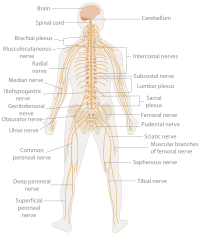
Photo from wikipedia
Glutamate is one of the most abundant amino acids in the blood. Besides its role as a neurotransmitter in the brain, it is a key substrate in several metabolic pathways… Click to show full abstract
Glutamate is one of the most abundant amino acids in the blood. Besides its role as a neurotransmitter in the brain, it is a key substrate in several metabolic pathways and a primary messenger that acts through its receptors outside the central nervous system (CNS). The two main types of glutamate receptors, ionotropic and metabotropic, are well characterized in CNS and have been recently analyzed for their roles in non-neural organs. Glutamate receptor expression may be particularly important for tumor growth in organs with high concentrations of glutamate and might also influence the propensity of such tumors to set metastases in glutamate-rich organs, such as the liver. The study of glutamate transporters has also acquired relevance in the physiology and pathologies outside the CNS, especially in the field of cancer research. In this review, we address the recent findings about the expression of glutamatergic system components, such as receptors and transporters, their role in the physiology and pathology of cancer in non-neural organs, and their possible use as biomarkers and therapeutic targets.
Journal Title: Frontiers in Endocrinology
Year Published: 2022
Link to full text (if available)
Share on Social Media: Sign Up to like & get
recommendations!